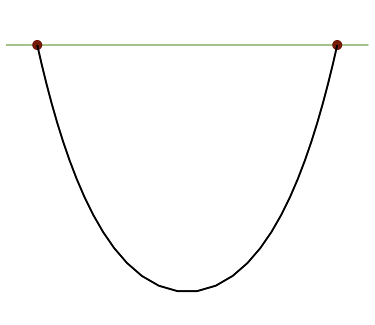
Once upon a time a couple of weeks ago, a friend raised a question: can you build an arch on a tiny planetoid? Or a giant arch on a normal-sized planet?
The mathematics of the arch are well-understood, but we usually think about them on a flat surface. That is, we assume the arch is much smaller than the planet it stands on, so gravity is "flat" (or close enough to flat that the difference doesn't matter.) What happens if the arch is nearly as large as the planet? Or larger? Can you build an arch from a pole to the equator? Can you build an arch from the north pole to the south pole?
My intuition said yes, but I didn't have any kind of model. So I spent a few hours messing around with one.
The natural shape of a free-standing arch is an upside-down catenary. The catenary is the natural shape of a hanging chain:

Every link of the chain feels a balance of forces. The adjacent links pull outwards along the line of the link (tension); and the weight of the link itself pulls downward (gravity). When the chain is at rest, all these forces balance out to zero.
This works upside-down because we've exactly inverted all the forces. We turn the chain link (a tension element) into a rod (a compression element), and so the adjacent rods push inwards along the line of the rod. And the weight of the rod pulls downward (gravity again). It all still balances, so this forms a balanced arch.
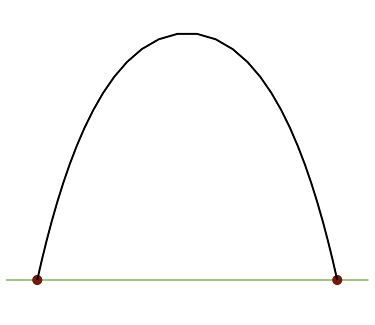
What's the point of this upside-down trick? Well, notice that the hanging catenary chain is stable -- if you nudge it, it swings back to the optimal shape. The standing catenary arch is unstable -- if you nudge it, it falls down in a heap! So the chain is a very handy way to calculate the optimal shape for the arch.
(This gets more important if you're piling up a lot of arches. Particularly if computers haven't been invented yet. You can find some fascinating pictures of Antoni Gaudí's architectural design models. They are upside-down string models for exactly this reason -- to "compute" the optimal structure of a set of standing arches.)
I built a quick test model of these chain-and-arch forms. You can play with them:
(These pages run in your browser using Javascript and SVG. They should work in all modern browsers.)
The simulation here is about as simplistic as it can get. I make a chain of points and treat each link as a rubber band with a constant weight. The "height" slider controls how long the rubber bands are. When you hit the "Go" button, they flop down (or up). There's no momentum; you can imagine them hanging in a viscous fluid. That doesn't affect the final shape, but it keeps the chain from bouncing around as it settles into that shape.
These models were just a dry run, of course. The real question is about arches on a planetoid. I figured I just had to run the same simulation using the Newtonian gravity field of a sphere.
I won't leave you in suspense (har har). It works fine!
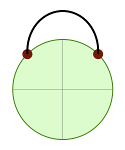

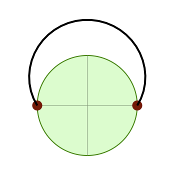
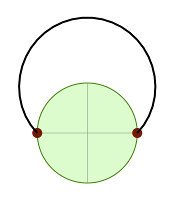

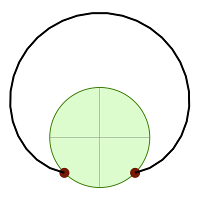
I'm ignoring rotation here, by the way. Assume the planetoid is non-rotating. If it rotates, that adds some kind of coriolis force which will skew the result. I'll let somebody else handle that correction.
The arch shapes look like ellipses, but I'm pretty sure they're not ellipses. (Catenary arches aren't parabolas.) Figuring out the exact formula would require differential equations, and I've forgotten all of those, but maybe somebody has the answer.
Here's the simulation model (again, SVG and Javascript). You'll find that the arch shape takes longer to stabilize if the height is large. Apply patience.
You can adjust the arch base from 90 degrees (a quarter of the way around the planet) to 270 degrees (three-quarters of the way around!) In fact there's no reason that 360 degrees shouldn't work, right?
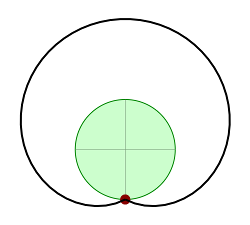
That's definitely not an ellipse... And you can go farther:
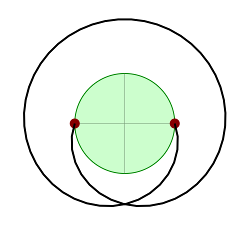
You don't have to connect that crossing point; there are no cross-forces there. But if you do connect it up, you can treat it as a 360-degree arch balanced on top of a 180-degree pointy (Gothic) arch.
For real fun, though, you want to start stacking arches on a sphere. I can imagine placing several arches around a sphere -- not just around the equator, but at different angles. Maybe with some interesting symmetry. Then you stack more arches on those, to form an encircling Gaudí-like cathedral, right? You'll need a more complicated chain simulation -- my code is two-dimensional and has no notion of linkages beyond one straight chain. But the same principles will work.
Sorry, no pictures. Just ideas. Exercise is left to the reader.
Updated September 4, 2016.